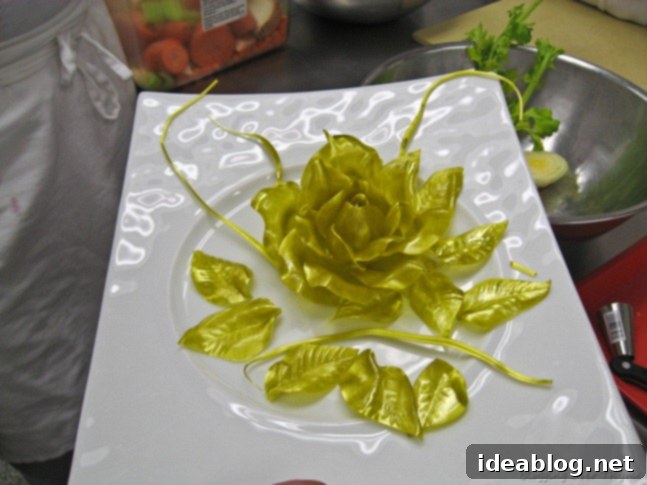A Day in Culinary School: From Fluffy Doughnuts to Challenging Calf’s Liver and Clarifying Consommé
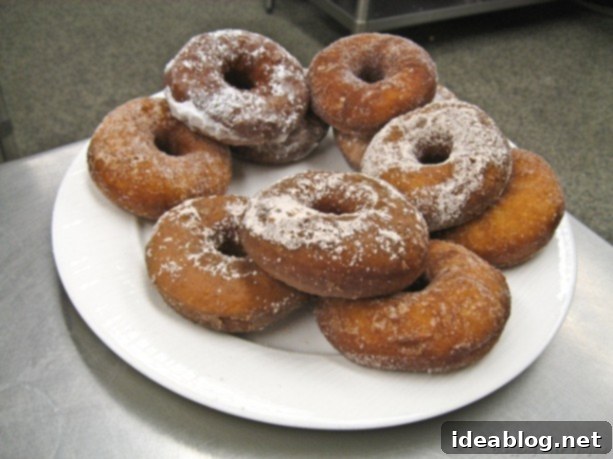
Wednesday brought a menu brimming with an ambitious array of dishes, each presenting its own unique set of culinary challenges and rewards. While some creations filled us with immense satisfaction, others, quite frankly, tested our palates and culinary resolve. I’ll delve into the less enjoyable aspects later, but let’s begin with the undisputed highlight of the day: the delightful doughnuts.
I’m confident that when you read the title, the mention of doughnuts immediately piqued your interest – and for good reason! They were, without a doubt, the dessert of the day and a truly successful endeavor. It’s funny how inspiration strikes; I recently acquired a doughnut pan, an impulse purchase fueled by a fleeting thought of baking, yet I had never actually attempted traditional yeast-risen, *fried* doughnuts before this. Today was the day to change that, and I couldn’t have been more excited to dive into the world of deep-fried deliciousness.
Our journey into doughnut perfection began the moment we stepped into the kitchen. The first crucial step was to meticulously put together our dough. We combined high-quality bread flour, fresh eggs, granulated sugar for sweetness, shortening for tenderness, water, active dry yeast to provide that essential lift, and a delicate touch of mace for a subtle, aromatic spice that elevates the flavor profile beyond the ordinary. Kneading the dough until it was smooth and elastic was a meditative process, a true foundation for the light and airy texture we were aiming for. Once kneaded to perfection, we gently wrapped the dough and allowed it to rest and proof. This critical fermentation stage, where the yeast works its magic, took approximately 45 minutes to an hour, during which the dough proudly doubled in size, promising a fluffy interior. The anticipation built with every minute, knowing that the perfect rise was key to a superior doughnut. Right before service, we carefully portioned and fried them to a beautiful golden brown, watching them puff up as they cooked.
My partner, Hadley, and I had a delightful time deciding on the finishing touches. We opted for a classic approach, coating a selection of the warm doughnuts simply in granulated sugar, allowing their pure, yeasty flavor to shine through. For a more aromatic variation, we generously tossed others in a fragrant mixture of powdered sugar and cinnamon. The contrast between the crisp, slightly chewy exterior and the soft, warm interior was simply divine. Each bite was a testament to the effort and care we put into them – absolutely delicious and a proud moment in our culinary journey!
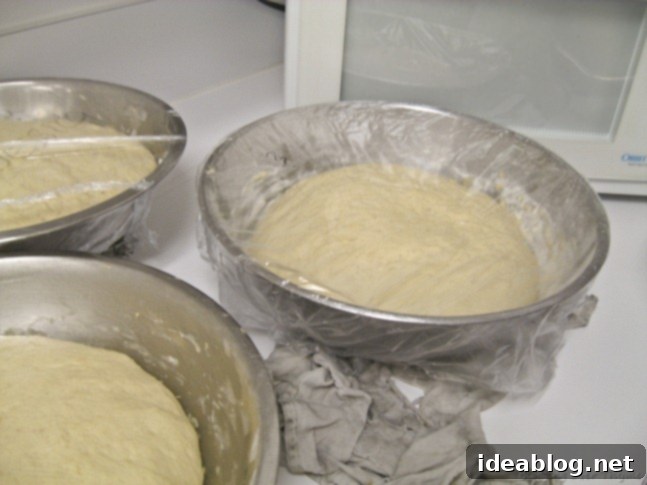
Another monumental dish on the day’s extensive menu was the classic consommé. Don’t let its seemingly simple appearance fool you; consommé is far from basic. It is, at its heart, a crystal-clear, amber-colored, intensely flavored, and fortified stock – a true benchmark of culinary skill and patience. Achieving that pristine clarity is a complex, multi-stage process that demands precision and attention to detail. We actually began the initial phase of this intricate preparation on Tuesday afternoon by creating the petite marmite. This foundational stage involves searing chicken bones to deepen their flavor and color, along with lean meat for added richness, a classic mirepoix (carrots, celery, onions), and crucially, onion brulee. Onion brulee consists of thick discs of onion that are essentially burnt on both sides, providing a deep, almost smoky aroma and a rich, golden hue to the stock without adding any bitterness. All these ingredients are then combined with chicken stock and left to gently simmer for approximately five hours. This extended simmering time is vital for extracting every last bit of flavor and nutrient, laying the groundwork for the extraordinary consommé to come.
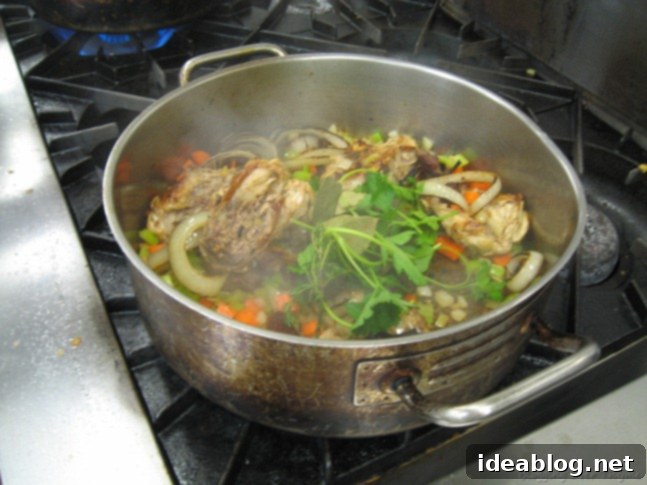
The second, and perhaps most fascinating, step is the clarification process itself. After the initial simmering, the petite marmite is carefully strained and then chilled. Chilling is essential as it solidifies any fats, making them easier to remove. Once thoroughly chilled, we combine equal parts of ground lean beef, finely ground mirepoix (to enhance flavor and aid clarification), and whipped egg whites. This mixture, known as the “clearmeat,” is then gently added to the cold, strained stock. The pot is slowly brought to a very low simmer. As the temperature gradually rises, the proteins in the ground meat and egg whites slowly coagulate, rising to the surface and forming a solid mass, which we refer to as a “raft.” This ingenious raft acts as a natural filter, trapping impurities and fats as the stock continues to gently cook underneath it, clarifying the liquid to an astonishing degree. A small “chimney” is often created in the center of the raft to allow for gentle simmering and efficient clarification.
The patience required during this stage is immense; rushing it would ruin the clarity. Eventually, when the raft had become impressively thick and firm, signaling that its work was complete, we painstakingly and slowly began ladling out the crystal-clear, clarified broth from underneath it. Each ladleful was then carefully strained through a fine-mesh chinois, ensuring absolutely no solid particles remained, resulting in a consommé of unparalleled purity and brilliance. It was a true marvel to behold the transformation from murky stock to a shimmering, translucent liquid.
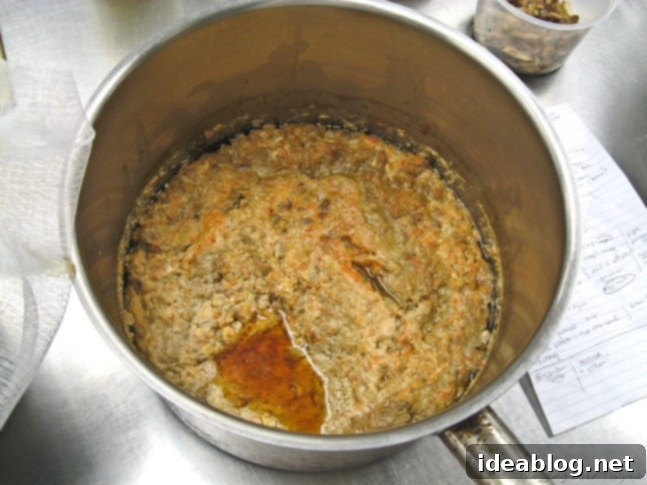
We proudly served our consommé as an elegant appetizer, garnished delicately with tender chicken mousse (yes, it made another appearance!) and perfectly sautéed shiitake mushrooms, adding textural and umami depth. Consommé, at its core, tastes like an intensely flavored, full-bodied stock – but elevated to an art form. Every spoonful delivered a profound richness and a clean finish that truly spoke of its careful preparation. Despite the kitchen being particularly hot that day, making a steaming bowl of soup not the most “refreshing” lunch choice, its exquisite flavor made it a thoroughly enjoyable and impressive dish. Its deliciousness was especially appreciated in stark comparison to our main course: calf’s liver!
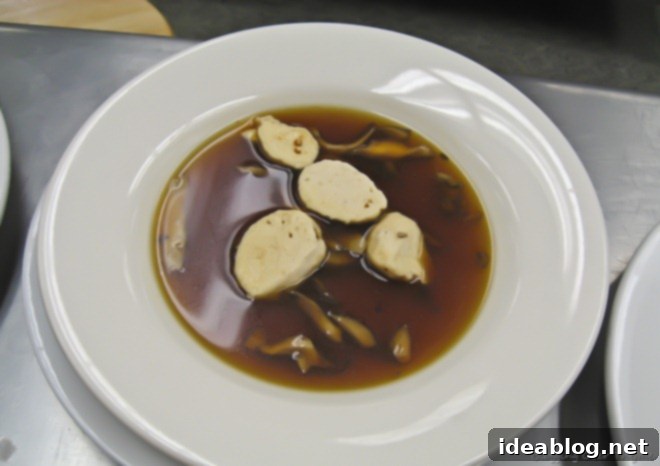
Beyond the main contenders, we also crafted delightful gougeres. These savory puffs are essentially a variation of pâte à choux dough, famously used for éclairs and cream puffs, but with a delicious twist: it’s generously mixed with grated Gruyère cheese. Once baked, they transform into light, airy, and utterly savory pastries, perfect for an appetizer or snack. The beauty of gougeres lies in their versatility; there are countless ways to customize them. For our version, we thoughtfully incorporated a pinch of cayenne pepper for a subtle warmth, a small amount of Dijon mustard to add a tangy depth, and a hint of nutmeg to complement the cheese and bring out its nutty notes.
They were surprisingly super easy to make, a true testament to the forgiving nature of pâte à choux once you understand the basic technique. Not only are they delicious, but they are also incredibly cost-effective to produce, making them a significant “money maker” at many restaurants. Their appeal is further enhanced by their convenience: gougeres can be prepared in advance, frozen, and then simply reheated in the oven right before serving, emerging warm and fragrant. This makes them an absolutely ideal appetizer to have on hand for entertaining or for a quick, elegant bite.
So far, everything on the menu sounds quite appealing, doesn’t it? Well, this is where the narrative takes a turn. Here comes the “bad part,” the culinary challenge that truly tested my boundaries and perhaps yours too.
Our main dish for the day was pan-seared calf’s liver, elegantly served with an echalote sauce. This sauce, a classic accompaniment, is crafted from a reduction of shallots, robust red wine, and a touch of red wine vinegar, which is crucial for cutting through the inherent richness of organ meats. In my entire life, I haven’t consumed much organ meat, primarily because the very idea of it rarely appealed to me in the *slightest*. However, a core principle of culinary school is to embrace every experience, to try absolutely everything presented, even the dishes that, in theory, sound rather unappetizing. I came to school with a commitment to expand my palate and confront my food prejudices, and today, that commitment was put to the ultimate test.
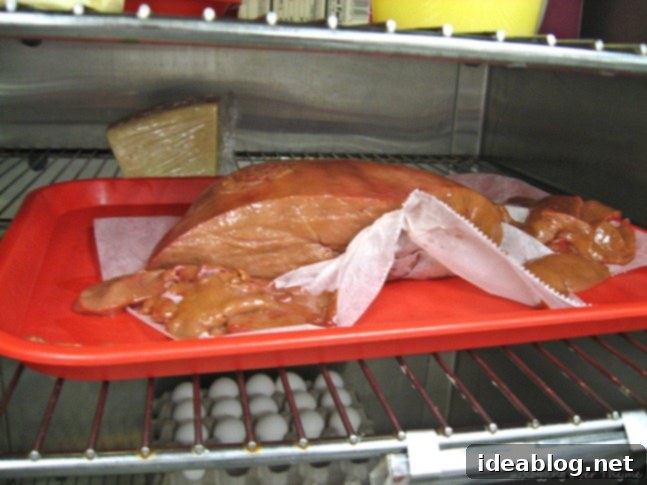
As Chef Brian demonstrated the preparation in class, I found myself wondering, perhaps optimistically, if I might actually end up liking it. Maybe, just maybe, calf’s liver was one of those dishes that sound off-putting but taste far better than you’d expect – a culinary surprise, akin to escargot. With cautious anticipation, I took a *tiny* bite, hoping for a revelation. NO! A resounding no! My hope was quickly dashed. I absolutely detested it. While the echalote sauce itself was genuinely good, offering a tangy counterpoint, the texture of the liver was incredibly unappetizing. It was soft, almost spongy, with a distinct minerally flavor that I simply couldn’t get past. Honestly, watching the entire preparation process, from its raw state to the finished product, was enough to make me feel quite queasy. It was a visceral experience, and not in a good way.
I think it’s fair to say that everyone in the kitchen knew there would be a significant number of untouched plates at lunchtime. Preparing the liver was an experience in itself. We had to carefully remove the thin outer membrane, which encases the organ, and then meticulously extract the inner vein – a delicate task that required precision. Once cleaned, we sliced the liver thinly, and its texture was notably delicate, almost “jello-y,” contributing to my initial reservations. Each slice was then lightly coated in flour, providing a protective crust, and pan-seared quickly in clarified butter, aiming for a perfectly medium-rare finish. Despite the careful preparation, my personal aversion remained.
Adding to the general lack of appeal, the specific piece I was working with looked distinctly unappetizing after searing – rather sadly, it resembled a forlorn, slightly charred banana peel! Haha, a moment of levity amidst the culinary distaste.
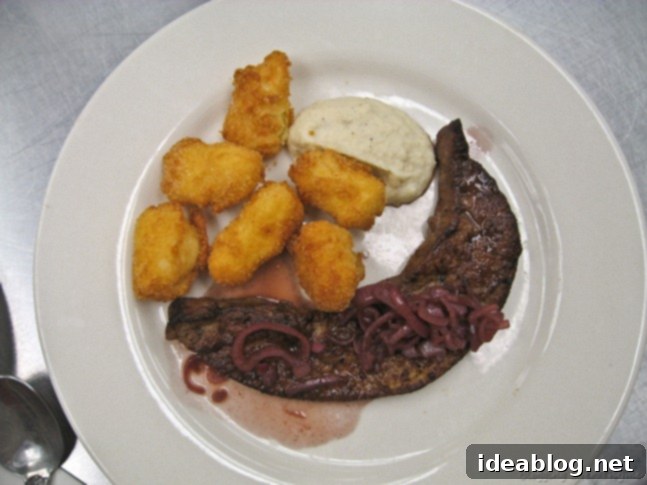
To accompany our controversial liver, we prepared a smooth and earthy celery root puree. This side dish was a comforting contrast, made by cooking celery root until tender with a little chicken stock, rich butter, and seasoned simply with salt and pepper. Once cooked, it was pureed in a food processor until incredibly smooth and then finished with a touch of cream, adding a luxurious mouthfeel. Despite my feelings about the main course, the celery root puree was undeniably good, offering a subtle sweetness and a wonderfully creamy texture that would have perfectly complemented a more appealing protein.
We also crafted pommes croquettes, a classic French potato preparation. These involve riced, cooked potatoes, which are then expertly mixed with egg yolks for binding and richness. The mixture is then piped into uniform logs, chilled thoroughly to firm up, before being cut into small, individual pieces. These pieces are subsequently breaded, creating a crispy exterior, and finally, deep-fried to a golden perfection. Essentially, they’re a fancy, elevated version of a tater tot, offering a delightful crunch and a creamy potato interior. While technically well-executed, I personally found them to be pretty boring in flavor compared to the other more adventurous dishes of the day. They certainly showcased technique, but lacked that certain “wow” factor for me.
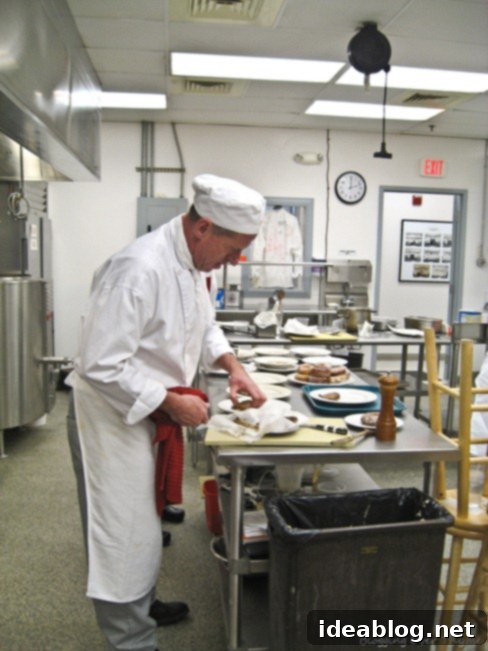
Tackling such a large and diverse menu with just one partner was an immense undertaking, a true test of our organizational skills, speed, and communication. The pressure was on to ensure every dish was prepared and plated to perfection, all while adhering to strict service timelines. Despite the myriad complexities and the sheer volume of tasks, we somehow managed to pull it off, miraculously serving everything on time. However, the moment we finally plated the last dish, a glance around the kitchen revealed the inevitable aftermath: it was a complete and utter mess.
This state of delightful chaos is pretty much how our professional kitchen looks every single day after a busy service! Pots, sauté pans, mixing bowls, and various utensils were scattered everywhere, each bearing the remnants of our culinary creations. There were splashes of sauce, stray vegetable trimmings, and flour dust covering nearly every surface. It’s a vivid snapshot of intense activity, the battlefield of a successful culinary operation. And then, of course, comes the equally demanding, and often less glamorous, “fun” part: cleaning it all up. This isn’t just a quick wipe-down; it’s a comprehensive sanitization.
Fortunately, our small class has evolved considerably over the weeks. We’ve become remarkably faster and far more organized in our collective approach to cleaning. What once seemed an insurmountable mountain of dirty dishes and equipment now gets handled with impressive efficiency. Our daily responsibilities extend beyond just our individual stations; we’re tasked with meticulously cleaning the entire kitchen, assisting the dishwashers with the mountain of plates, scrubbing down the classroom to sparkling condition, and organizing the commissary. It used to take us *forever* to complete these tasks, often stretching late into the afternoon. Now, it’s a well-oiled machine, a testament to teamwork and improved systems. As our chefs always wisely quip, “the kitchen is my gym.” And while I can’t definitively say that all the scrubbing and heavy lifting completely burn off the calories from our tasting sessions, it genuinely is a full-body workout. The physical demands of culinary school are significant, combining mental focus with considerable physical exertion, turning every cleanup into an unexpected fitness routine.
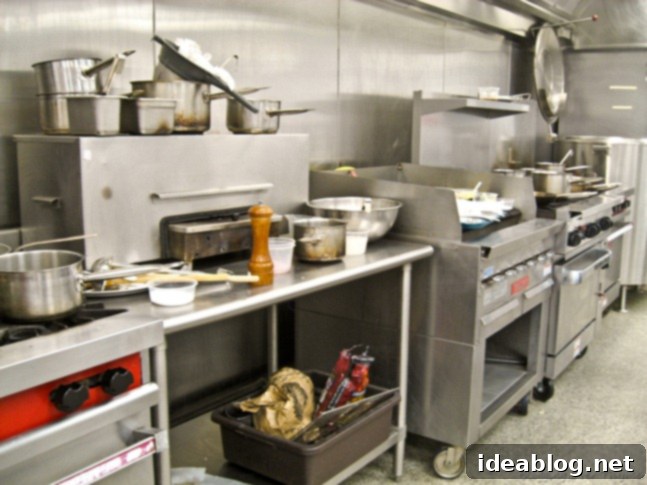
By the end of such an exhaustive day, with the kitchen finally pristine and our tasks complete, we all felt utterly exhausted. Not to mention, the constant heat from the stoves and ovens left us thoroughly overheated, a common reality in a professional kitchen environment.
On a delightful side note, amidst the day’s rigorous cooking and cleaning, we had the privilege of admiring an exquisite creation by one of the pastry program instructors. It was a truly beautiful pulled-sugar flower, a delicate masterpiece showcasing incredible artistry and skill. The intricate details and vibrant colors were astonishing, providing a moment of pure inspiration and a reminder of the diverse talents within our culinary institution. So cool!
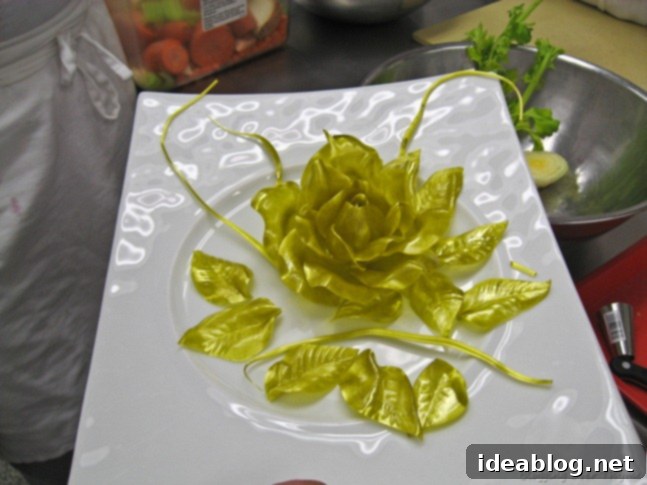
I’ll be back soon with another update on Thursday’s class, ready to share more adventures from my culinary journey. Luckily, I can confirm that it did not involve any more calf’s liver… a fact for which my palate remains eternally grateful!
